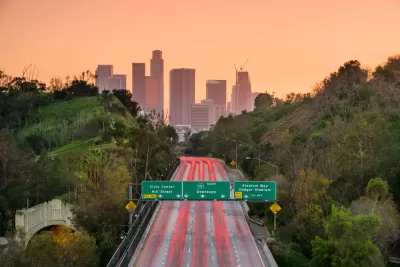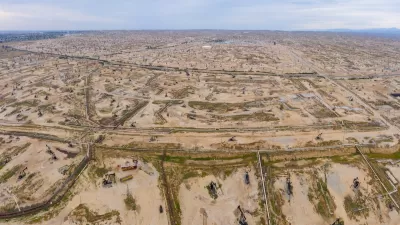Encouraging compact land use by allowing density, building near transit, and eliminating parking minimums can have a powerful effect on the emissions a city generates.

Liberal cities around the country have mayors who love to talk about climate change, but while there are proven strategies to curb emissions in cities, many of these same mayors are afraid to upset the status quo. Transportation is the main source of emissions in the United States, so "[m]ayors can play a big role in reducing per capita energy consumption by facilitating more efficient modes of travel and more compact land use," argues Angie Schmitt.
Eliminating parking requirements is one strategy that's been implemented in Mexico City. Parking requirements make building more expensive and serve as built-in support for private vehicles over public transit. While a few U.S. cities have taken steps to reduce some requirements, none has gone as far as the Mexican capital.
Other strategies Schmitt champions in her article include creating space for sustainable transit in the form of bus and bike lanes, allowing housing near transit, and narrowing streets and slowing vehicle traffic to make the public realm safer for walkers and bikers.
FULL STORY: You’re No “Climate Mayor” If You’re Not Doing These Four Things

Trump Administration Could Effectively End Housing Voucher Program
Federal officials are eyeing major cuts to the Section 8 program that helps millions of low-income households pay rent.

Planetizen Federal Action Tracker
A weekly monitor of how Trump’s orders and actions are impacting planners and planning in America.

Ken Jennings Launches Transit Web Series
The Jeopardy champ wants you to ride public transit.

California Invests Additional $5M in Electric School Buses
The state wants to electrify all of its school bus fleets by 2035.

Austin Launches $2M Homelessness Prevention Fund
A new grant program from the city’s Homeless Strategy Office will fund rental assistance and supportive services.

Alabama School Forestry Initiative Brings Trees to Schoolyards
Trees can improve physical and mental health for students and commnity members.
Urban Design for Planners 1: Software Tools
This six-course series explores essential urban design concepts using open source software and equips planners with the tools they need to participate fully in the urban design process.
Planning for Universal Design
Learn the tools for implementing Universal Design in planning regulations.
Ada County Highway District
Clanton & Associates, Inc.
Jessamine County Fiscal Court
Institute for Housing and Urban Development Studies (IHS)
City of Grandview
Harvard GSD Executive Education
Toledo-Lucas County Plan Commissions
Salt Lake City
NYU Wagner Graduate School of Public Service





























